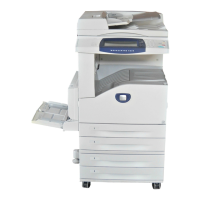Network Configuration
WorkCentre™ 5735/5740/5745/5755/5765/5775/5790
System Administrator Guide
103
5. In the Authentication Failure Generic Traps area, check the [Enable] checkbox to enable
Authentication Failure Generic Traps to generate a trap for every SNMP request by the device
which contains an invalid community name.
Note: When the Authentication Failure Generic Trap is enabled, this machine will generate a trap
for every SNMP request that is received by the machine which contains an invalid community
name.
6. Click on the [Apply] button to save changes, or click on the [Advanced Settings] button to add or
edit an IP or IPX Address. For further information refer to SNMP Advanced Settings on page 104.
7. Click on the [OK] button when you see the message “Properties have been successfully
modified”.
To configure SNMP v3
Note: To configure this feature or these settings access the Properties tab as a System
Administrator. For details, refer to Access Internet Services as System Administrator on page 24.
1. From the Properties tab, click on the [Connectivity] link.
2. Click on the [Protocols] link.
Note: SSL (Secure Socket Layer) must be enabled before you can configure SNMP v3. Click the
[Configure HTTPS] link on the SNMP Internet Services screen to complete this task. When SSL is
enabled, return to the SNMP screen.
Before, enabling the HTTP Security Mode, the device must have a Machine Digital Certificate
configured. For information on Machine Digital Certificate, refer to Security Certificate
Management on page 179.
3. Select [HTTP] in the directory tree.
a. Select enable for the [Secure HTTP (SSL)] option.
b. Change the [Secure HTTP (SSL) Port Number] if required. The default is 443.
c. Click on the [Apply] button to accept the changes.
4. Select [SNMP] in the directory tree.
5. To configure SNMP v3, in the SNMP Properties area:
a. Check to ensure the [Enable SNMP v3 Protocols] checkbox is selected.
b. Click on the [Edit SNMP v3 Properties] button.
System Administrator uses the Edit SNMP v3 Properties page to configure Authentication
Password and Privacy Password for the Administrator Account.
6. In the Administrator Account area:
a. Check the [Account Enable] checkbox to create an administrator account that can be used
to provide more extensive access to the objects on the device.
b. Enter the required data in the [Authentication Password] and [Confirm Authentication
Password] fields.
c. Enter the required data in the [Privacy Password] and [Confirm Privacy Password] field.
7. In the Print Drivers/Remote Clients Account area:
a. Check the [Account Enabled] checkbox to Create an account for bi-directional Print Drivers
and Xerox remote clients.

